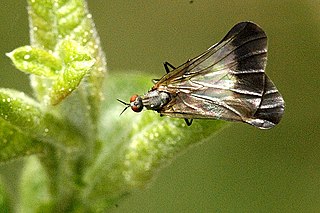| Sphicosa | |
|---|---|
| Scientific classification | |
| Domain: | Eukaryota |
| Kingdom: | Animalia |
| Phylum: | Arthropoda |
| Class: | Insecta |
| Order: | Diptera |
| Family: | Empididae |
| Subfamily: | Empidinae |
| Genus: | Sphicosa Philippi, 1865 [1] |
| Type species | |
| Sphicosa nigra | |
| Sphicosa | |
|---|---|
| Scientific classification | |
| Domain: | Eukaryota |
| Kingdom: | Animalia |
| Phylum: | Arthropoda |
| Class: | Insecta |
| Order: | Diptera |
| Family: | Empididae |
| Subfamily: | Empidinae |
| Genus: | Sphicosa Philippi, 1865 [1] |
| Type species | |
| Sphicosa nigra | |

Rhamphomyia is a genus of dance flies, in the fly family Empididae. It contains more than 600 species in 8 subgenera.

Tachydromiinae is a subfamily of hybotid flies widespread in the world.

Ocydromiinae is a subfamily of hybotid flies.

Drapetini is a tribe of hybotid flies widespread in the world. There are 19 currently recognised genera. See the Wikispecies link below for details.

Brachystomatinae is a subfamily of flies belonging to the family Empididae.

Empidinae, also called dance flies, are a subfamily of empidoid flies. They are mainly predatory flies like most of their relatives, and generally small to medium-sized. Most species are flower visitors and they can be effective pollinators.
Apalocnemis is a genus of flies in the family Empididae.
Hyperperacera is a genus of flies in the family Empididae.
Allochrotus is a genus of flies in the family Empididae.
Aplomera is a genus of flies in the family Empididae.
Atrichopleura is a genus of flies in the family Empididae.
Deuteragonista is a genus of flies in the family Empididae.
Hilarigona is a genus of flies in the family Empididae.
Hilarempis is a genus of flies in the family Empididae.
Cladodromia is a genus of flies in the family Empididae.
Neoplasta is a genus of flies in the family Empididae.

Drapetis is a genus of flies in the family Hybotidae.
Austrodromia is a genus of flies in the family Hybotidae.